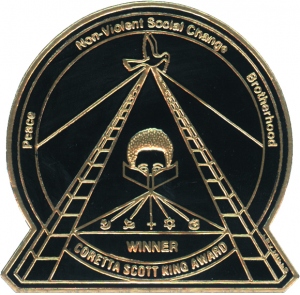Racial diversity pertains to the categorization of individuals based on physical characteristics and shared ancestry. Some examples of racial groups include: African, Alaska Native, Asian, Caucasian, Latinx, Pacific Islander, etc. Racial categories can be further divided into various national origins. For instance, Asian could encompass individuals with Chinese, Japanese, Korean, or Indian heritage. An An ethnonym is a term assigned to a specific ethnic group, tribe, or people. Examples include: American, Canadian, Navajo, Mennonite, and Orthodox Christian.

Huyck, David and Sarah Park Dahlen. (2019 June 19). Diversity in Children’s Books 2018. sarahpark.com blog.
Books in this tab are about Africa the country and written by African authors as well as African American experiences. In this context, the term "African American" describes books that prominently showcase Black characters, stories, and cultural experiences. These works are frequently authored and illustrated by African Americans, providing diverse perspectives that promote equity and inclusion in the classroom. This allows young readers to see themselves represented in the narratives while gaining a deeper understanding of African American culture and history.

LINKS
The term "Asian" encompasses individuals with origins from the Far East, Southeast Asia, and the Indian subcontinent, including countries such as China, Japan, Korea, Vietnam, India, the Philippines, Thailand, Cambodia, Malaysia, and others. Essentially, it refers to anyone with ancestral ties to the continent of Asia. This category also includes Asian Americans and Pacific Islanders who trace their heritage to specific Asian countries or cultural groups such as Hmong, Mongols, or Brahuis .
Pacific Islanders are those descended from the indigenous populations of the Pacific Islands, which include locations like Hawaii, Guam, Samoa, and various other islands. This designation covers individuals whose ancestry hails from the original groups of Polynesia, Micronesia, and Melanesia. Polynesia features regions such as Hawaii (Native Hawaiian), Samoa (Samoan), American Samoa (Samoan), Tokelau (Tokelauan), Tahiti (Tahitian), and Tonga (Tongan).
Asian American literature, which also encompasses AAPI (Asian American/Pacific Islander) and Native Hawaiian narratives, is a vibrant genre of children's literature that features a variety of stories from different cultures, typically written by authors of Asian descent. These tales capture the experiences of Asian American communities—including but not limited to Chinese, Japanese, Vietnamese, Indian, and Pacific Islander—allowing young readers to find representation and cultivate pride in their cultural heritage. The literature ranges from ancient folklore to contemporary stories, delving into themes of family, tradition, resilience, and cultural identity. It fosters empathy by inviting readers from all backgrounds to explore diverse cultures. The inclusion of Asian American perspectives adds depth to children's literature, ensuring that every child can see their own experiences reflected in the stories they encounter.
Links
Indigenous peoples are culturally unique groups with a historical bond to the land and natural resources of their regions. Typically, they are the descendants of those who lived in an area prior to the arrival of individuals from other cultures or ethnic backgrounds. Found worldwide, from the Arctic to the South Pacific, they are defined as the descendants of those who inhabited a country or geographical area when people from diverse cultures or ethnic origins first arrived.
LINKS
The term "Hispanic" is a source of debate; some consider it offensive or outdated. Additionally, there are concerns regarding the terms Latino, Latina, and Latinx, particularly due to the gendered nature of the Spanish language. The Library of Congress uses the term Hispanic as a subject term for finding books where Latino/a/x, or Chicano is searchable in key words only. Chicano is a term that Mexican Americans in the U.S. Southwest historically used to describe their heritage (some find this term offensive or outdated but older books may use this term).
LINKS
The phrase "Middle Eastern" pertains to individuals with roots in West Asia and/or North Africa. This geopolitical term encompasses the intercontinental area that includes the Arabian Peninsula, Turkey, Iran, and Iraq, as well as Egypt and parts of North Africa. It represents various ethnic groups such as Arabs, Persians (Iranians), Turks, Kurds, Druze, Berbers, and Armenians, among others.
LINKS